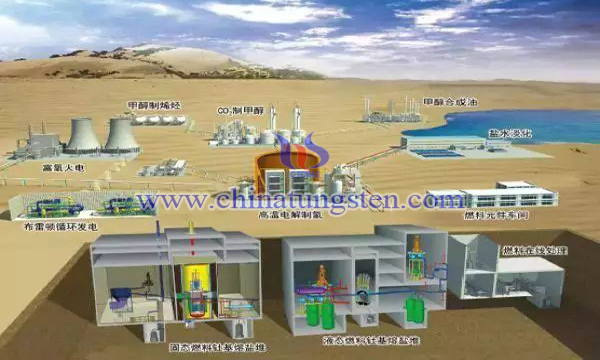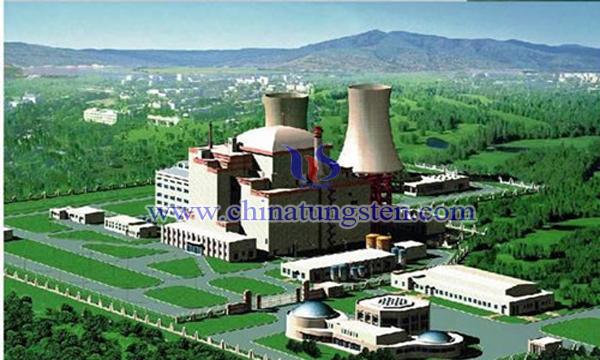New Nuclear Reactor Core is Inseparable from Tungsten and Molybdenum
- Details
- Category: Tungsten's News
- Published on Sunday, 05 August 2018 21:50
According to Hongkong's South China Morning Post on December 5th, China will invest in developing two molten salt reactors, a nuclear technology that has been abandoned during the cold war, but it is a more theoretically safer and more efficient nuclear technology. In fact, China is not the only country that tries to reactivate the technology, and the US, Russia, France and Japan are all concerned about the technology, but China seems more serious. This is because the demand of nuclear power plant and uranium is as high as 85%, far exceeding the international warning line of 50%, but the main fuel - thorium in the new type of molten salt reactor is the top of the world in our country. Therefore, the development of the fourth generation new type of molten salt nuclear reactor has a different significance.

According to Hongkong's South China Morning Post on December 5th, China will invest in developing two molten salt reactors, a nuclear technology that has been abandoned during the cold war, but it is a more theoretically safer and more efficient nuclear technology. In fact, China is not the only country that tries to reactivate the technology, and the US, Russia, France and Japan are all concerned about the technology, but China seems more serious. This is because the demand of nuclear power plant and uranium is as high as 85%, far exceeding the international warning line of 50%, but the main fuel - thorium in the new type of molten salt reactor is the top of the world in our country. Therefore, the development of the fourth generation new type of molten salt nuclear reactor has a different significance.
What is a molten salt pile? It is understood that the molten salt reactor uses high temperature molten salt as a coolant, which has high temperature, low pressure, high chemical stability, Gao Rerong and other thermal properties. It is not necessary to use heavy and expensive pressure vessels. It is suitable for compact, lightweight and low-cost small modular reactors. The molten salt reactor uses a water free cooling technology. It only needs a small amount of water. The high temperature nuclear heat produced by the molten salt reactor can be used for power generation. It can also be used in industrial heat application, high temperature hydrogen production and hydrogen absorption of carbon dioxide to make methanol. It is an effective solution to achieve high efficiency and replace the coal power plant in the arid and less rain areas in the north of China.

In addition, miniaturization is the most critical feature of the molten salt reactor. Once it is successfully developed, it will be used for nuclear powered submarines, nuclear powered aircraft carriers and even nuclear powered space shuttle to the moon or Mars. During the cold war of the 50s of last century, the Soviet Union and the Soviet Union had tried to make nuclear powered bombers by using the lava reactor scheme, but for technical reasons, the nuclear bomber plans of the two countries were finally dead and silently downline. It is said that researchers at the time had encountered problems in trying to reduce the size and weight of the reactor, and one of the main problems was that the hot salt used in the fission process could cause corrosion in the pipe and nuclear reaction chamber, which was the biggest trouble in the molten salt reactor, and the alloy material at that time could not solve the problem. Recently, Chinese scientists have claimed to have found nickel-based superalloys resistant to molten salt corrosion, which contain tungsten and molybdenum as transition metal elements.
The corrosion properties of nickel based alloys with different amounts of Cr, molybdenum Mo and tungsten W and other enhanced phase elements in the molten FLiNaK at 850 C were studied. The results showed that the selective dissolution and diffusion of Cr was the main cause of corrosion in the molten salt reactor. It is necessary to restrain the external diffusion of the elements of the alloy to inhibit the selective dissolution of the elements such as Cr. The application of diffusion barrier may be a simple and effective way. In addition to inhibiting the external diffusion of the elements, this kind of diffusion barrier must have high chemical stability in the molten salt system, and the alloy (Hastelloy-N and Haynes 230) adding Mo and W refractory metals (Hastelloy-N and Haynes) precipitated rich Mo and W rich phases along the grain boundary after corrosion, indicating that the corrosion resistance of Mo and W is better, and the molten salt is molten salt. A necessary reinforcement element for the reactor.
After years of research and government funding, Chinese scientists have developed special alloys and coatings to prevent chemical corrosion. The molten salt reactor built in Gansu aims to prove the feasibility of this technology. If the verification is successful, China's molten salt reactor technology first breaks through the technical bottleneck and becomes the first country in the world to own fourth generation nuclear energy technology. The first nuclear powered aircraft carrier system in China will soon be put on the agenda. But the role of molten salt reactors is not only military, but also for the construction of small nuclear power plants at sea, small nuclear power plants and other civilian energy fields, which play a far-reaching role, or will change our future energy structure.
Copyright statement: This article is used only for the China Tungsten Industry Association and China Tungsten Online. Any individual without written permission or without the copyright and the source is not allowed to copy or reprint without authorization. Otherwise, this website will be regarded as a tort, and the website will be investigated for its legal responsibility.
- Tungsten Manufacturer & Supplier, Chinatungsten Online: www.chinatungsten.com
- Tungsten News & Prices of China Tungsten Industry Association: www.ctia.com.cn
- Molybdenum News & Price: news.molybdenum.com.cn
- Tel.: 86 592 5129696; Fax: 86 592 5129797; Email: sales@chinatungsten.com



 sales@chinatungsten.com
sales@chinatungsten.com